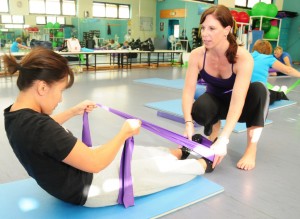Is There Value Stretching Before Exercise?
February 21, 2011 by Eric
Filed under Fitness and Exercise
Is risk of injury really reduced by pre-exercise stretching?
Do you follow the common belief of performing a stretching routine prior to exercise? A recent study in the Clinical Journal of Sport Medicine says it does not. Apparently, scientific evidence does not really support the thinking that injury would be prevented or decreased by stretching before exercise. Only when pre-exercise stretching was performed with a warm-up prior to the stretching was it shown to have any benefit. The following is a list of 5 reasons that injury is not prevented by pre-exercise stretching:
1. Immobilization is more likely to be the cause of soft-tissue injury.
2. A regular stretching routine shows no benefit to eccentric motion in exercise (the negative repetition) where muscle strains are mostly believed to occur.
3. Eccentric muscle activity (motions in which muscles lengthen and contract simultaneously) are not benefited by stretching.
4. Skeletal level damage can occur by stretching.
5. Muscle pain may be masked by stretching, which may lead the exerciser to ignore important signals from the body.
Through clinical and scientific evidence; today ‘s theories on stretching suggest that injury may be caused, not prevented, by stretching prior to exercising. So how then should one warm-up before exercise? There are several techniques that have been found effective that focus on warming up by increasing muscular and body core temperature. One can achieve these increases in body temperature by relying on the use of saunas, liniments, and heating pads. Another method is the all to familiar Jumping Jack; this general type of warm-up refers to increasing temperature by nonspecific, generalized movements. Finally, one should try some individual exercises to warm up specific body parts that will be particularly exerted in the forthcoming exercise, such as squats for your legs before a good run. This insures that the muscles in the particular limb/limbs will have a chance to increase their temperature before being strained.
The most effective method for pre-exercise warm ups seems to be the specific body part warm-up techniques: doing at least one or two sets of warm-ups for each body part to be trained is recommended. There are also several techniques for safe stretching, like controlled, gentle, swinging of legs and arms, which approach the limits of motion range (referred to as dynamic stretching) that can improve blood flow and warm muscles and joints before working them. Torso twists and slow leg and arm swings are examples of this technique. It is important to remember that while doing these dynamic stretches not to force or bounce to stretch even further, as this can actually do more harm than good. These repetitive and bouncing motions are referred to as ballistic stretching and can result in muscle overload and, therefore, should be avoided as it can be dangerous.
Static Stretching is the most common method of stretching where the muscle is forced to a point and is held there for an extended period. It is important to find a routine that is best suited to your needs. Finally, the scientific evidence, points to a conclusion that unless it is used in conjunction with a warm-up, pre-exercise stretching is not effective in reducing or preventing the risk of injury when exercising. So once again, a pre-workout warm-up, is regarded by most professional fitness people as a more valuable approach. So will you reconsider your old stretching routine ritual?



